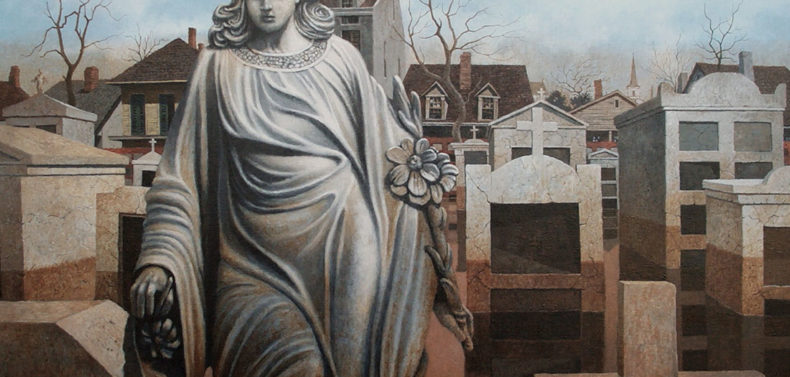After nearly four months of staying closed due to the pandemic, the Georgia Museum of Art has officially reopened its galleries for in-person viewing of multiple new exhibitions. Coincidentally opened the same week that Hurricanes Marco and Laura struck Louisiana, “Hurricane Katrina and Its Aftermath in the Art of Rolland Golden” memorializes the natural disaster’s destruction 15 years later. Golden, a New Orleans native who died last year, depicts The Big Easy at one of its most difficult periods through narrative paintings that are both beautiful and bleak.
Though dispirited by the devastation and briefly contemplating retirement, Golden instead rallied to channel the heartbreak into a series of paintings documenting a community left physically and emotionally crushed. Launching the series, “Silent Vigil” had initially been intended as a portrait of a statue in a rural Mississippi cemetery before the storm. Returning to his home post-Katrina, however, Golden modified the in-progress painting to set it in a flooded New Orleans cemetery, adding a water stain below the woman’s knees to mark the passage of time. The magnitude of Katrina’s wrath becomes clear: Not even the dead were left to rest peacefully.

Known for his realism, Golden occasionally dipped into a subtle surrealism that intensified and questioned the uncanny details of perception. In “Early Spring Rain Near the Levees,” orange skies appear even brighter upon the surface of floodwaters snaking their way in between dilapidated homes. The surreal nature of his work is best observed in “Coming Back,” a piece that juxtaposes a row of newly built houses across the street from the shambles of a destroyed home. The fallen beams lie across a checkerboard ground to resemble a chess game and suggest that life is a series of chances and strategies.
Spotlighting a former artist-in-residence at UGA’s Lamar Dodd School of Art who taught from 1948–1950, “Carl Holty: Romantic Modernist” follows the German-born, Wisconsin-based artist as he explores the evolving language of 20th Century modernist movements. During a career that spanned more than five decades, he moved from realism to cubism to abstraction alongside friends and mentors such as Hans Hofmann, Piet Mondrian, Stuart Davis, Joan Miró and Mark Rothko.

Holty’s early paintings reward the observant viewer: What appear at first glance to be confetti-like bursts of boldly colored blocks gently reveal themselves to be nudes and bathing scenes. By his final chapter, his use of color shifts from having a loud presence to playing a more atmospheric role, such as in the patchwork of muted dirt tones “Desert Night.” Holty’s dedication to color, shape and form combines with the romantic ideals of his subject matter—bathers, horses, nature, still life—for works that allow biomorphic forms to move freely without spatial or conceptual restrictions.
The museum’s third new show, “Contemporary Japanese Ceramics from the Horvitz Collection,” demonstrates how a centuries-old art form continues to take new shape. On view for the next year, the exhibition represents three generations of artists who were associated with or influenced by Sodeisha, a groundbreaking group of avant-garde ceramicists who formed in the late 1940s in opposition to the utilitarian, folk-craft style and philosophy that dominated at the time.
Carol and Jeffrey Horvitz began collecting contemporary Japanese ceramics in 2008 and have since amassed over 800 works by over 300 artists—making their collection one of the largest of its kind outside Japan. Frequently taking trips to visit artists in their workshops and studios, the Boston-based couple specifically skip kitsch and figurative work in favor of objects that appear to be rooted in Japanese tradition—whether by continuation or rejection.

Connected by their skilled craftsmanship and sophisticated detail, the works here collectively hint at a meticulous experimentation with surface and texture. Inspired by the range of blues found between sea and sky, Kimura Yoshiro’s sleek orb-shaped sculpture uses traditional aquamarine glaze to create a deep pool of color below the glossy surface. Meanwhile, Itabashi Hiromi’s “The Area of Black” resembles a gritty monolith through the artist’s technique of firing pulverized clay within a framework of glazes.
The museum is currently open with limited hours: Thursday 10 a.m.–9 p.m., Friday and Saturday 10 a.m.–5 p.m. and Sunday 1–5 p.m. In-person events are canceled for the rest of the year, but popular events like Yoga in the Galleries, Morning Mindfulness and Family Day will continue virtually. Visitors are asked to follow basic safety precautions by wearing a face mask, maintaining six feet of distance from others and taking advantage of hand-sanitizing stations. To limit the number of people inside the building at once, visitors must reserve a free ticket for a specific time slot in advance at georgiamuseum.org.
Like what you just read? Support Flagpole by making a donation today. Every dollar you give helps fund our ongoing mission to provide Athens with quality, independent journalism.










